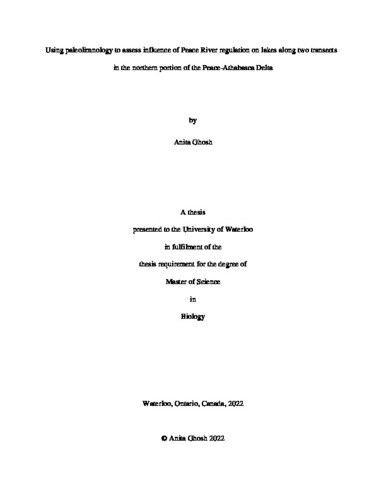| dc.description.abstract | The Peace-Athabasca Delta (PAD), northern Alberta, Canada, is an ecologically and culturally important floodplain where debate has persisted for more than 60 years about causes of water-level drawdown of its abundant, shallow perched lakes. Hydroelectric regulation of Peace River flow by the W.A.C. Bennett Dam, located ~1100 km upstream of the delta at the river’s headwaters, is widely considered to be the main cause of perched lake drying via reduction in occurrence of ice-jam flood events. However, prior paleolimnological studies have identified that flood frequency and lake levels began to decline in the late 1800s and early 1900s, many decades before construction of the dam, in response to climate change. Here, we further assess for evidence of shifting lake hydrology associated with the timing of river regulation using analyses of sediment cores from twelve lakes in the northern portion of the PAD. Lakes were arranged along two transects adjacent to Moose Island and Rocky Point, respectively, that span a 27-km stretch of the Peace River and vary up to 9.7 km from the river. Sediment cores from each lake were analyzed for variation in sediment composition by loss-on-sequential-heating, and organic carbon and nitrogen elemental and isotope composition to reconstruct past hydrological change. Cores from seven of the lakes possessed sediment records that could be dated using activity profiles of 210Pb and 137Cs. Mineral matter content, C/N ratios, and δ15N decline in upper strata of all the sediment cores, trends that can be interpreted as consistent with observations and other evidence of reduction in flood frequency at the Peace sector of the PAD. Use of breakpoint analysis identified that 17 of 21 records (3 sedimentary variables x 7 lakes with dated cores) infer a decline of river influence one to five decades after 1968, whereas only 3 records infer a decline of river influence coincident with 1968. These findings do not provide strong support for widely held contention that perched lake drying at the PAD began in 1968 due to effects of the W.A.C. Bennett Dam on the ice-jam flood regime. Instead, climatic shifts to lower snowpack and warmer temperatures since at least the mid-1970s appear to be a main driver. However, it is not possible to discount the possibility that climatic trends may have caused the river flow regime to pass a threshold and delay effects of the W.A.C. Bennett Dam. Regardless of the cause, perched lake drawdown in the PAD has negative consequences for ecosystem function and Indigenous land users, and requires adaptative and/or mitigative strategies. | en |

